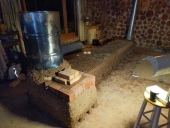
























Just call me Uncle Rice.
17 years in a straw bale house.
 1
1




 1
1








 3
3




Pecan Media: food forestry and forest garden ebooks
Now available: The Native Persimmon (centennial edition)
 1
1




"Yeah, well, that's just, like, your opinion, man" - The Dude
"It is what it is til it aint" - Mac Miller
 2
2




Dan Boone wrote:I have been theory-crafting about this and I am starting to wonder whether, in some applications, I couldn't get away with plain old mud? By which I mean, just the local sand/clay soil mixed with a bit of water?
Here's my thinking. I want to make some small durable outbuildings. (Chicken coop, dovecote, storage shed, small workshop, that sort of thing.)
Literally the only building materials I have in surplus are local roundwoods (red cedar, osage orange, honey locust, elm, ash, anything in the cross-timbers mix, as much as I can cut) and local dirt. No large clay deposits, no decent/sorted sand or gravel, no huge quantity of sawdust. Money, of course, is tight. I can buy supplies but not in building-materials quantities, if that distinction makes sense.
This is Oklahoma. I don't really need great thermal properties. What I need is durability and the ability to keep wind and rain off my stuff.
I've been watching cordwood construction videos. Everybody uses either short sticks (six inches) or longer sticks stacked across two ridges of mortar, with an air gap or insulation between for insulation. In virtually all cases, they use huge thick layers of mortar, such that the filled gaps between stacked sticks is often an inch or more. And then they often complain about various mortar failures. When half your wall is mortar, that's a disaster! And so we have endless recipes for improved mortars.
I grew up in a town full of 100-year-old log cabins. They were chinked with moss that was then coated with mud -- with the "mud" being some forgotten mix of Yukon River silt and perhaps a bit of lime. If the mud cracked and fell out (sometimes helped by bored little fingers) the cold air came whistling in. And that often happened. The walls were only six to ten inches thick, so the tiniest gap would pass too much frigid air.
However, I have a LOT of experience stacking cordwood. At longer lengths (especially 18 to 24 inches) you can stack it very tightly and it's never going to move. Why use mortar at all? Well, because the tightest woodpile will still pass drafts. But I don't understand why just a thin slip of mud/mortar to bed each new stick in wouldn't be sufficient to fix that. And you wouldn't need to run it all the way out to the ends of the your stack/wall, so it wouldn't be exposed to the elements (or child fingers) and even if it crumbled, it wouldn't go anywhere. It wouldn't be structurally significant, or at least not very.
I mean, I would need a good solid foundation that keeps water out of contact with the wood. And I would need a good roof to minimize water from above/sideways. But for a structure on the line between warm temperate and subtropical, I don't see why thick cordwood walls with very little mortar of any kind in them (just enough to stop drafts) wouldn't work. No need to build a void into the wall for insulation, no need for inches-thick layers of mortar between your stacked roundwoods.
Am I completely insane? Or, for the purpose of outbuildings that don't need much climate control, is this a viable method?
A build too cool to miss:Mike's GreenhouseA great example:Joseph's Garden
All the soil info you'll ever need:
Redhawk's excellent soil-building series





 1
1








To be is to do …Kant
To do is to be ..Nietzsche
Do be do be do…Sinatra
Scooby dooby do …St. Thomas

| I agree. Here's the link: http://stoves2.com |





